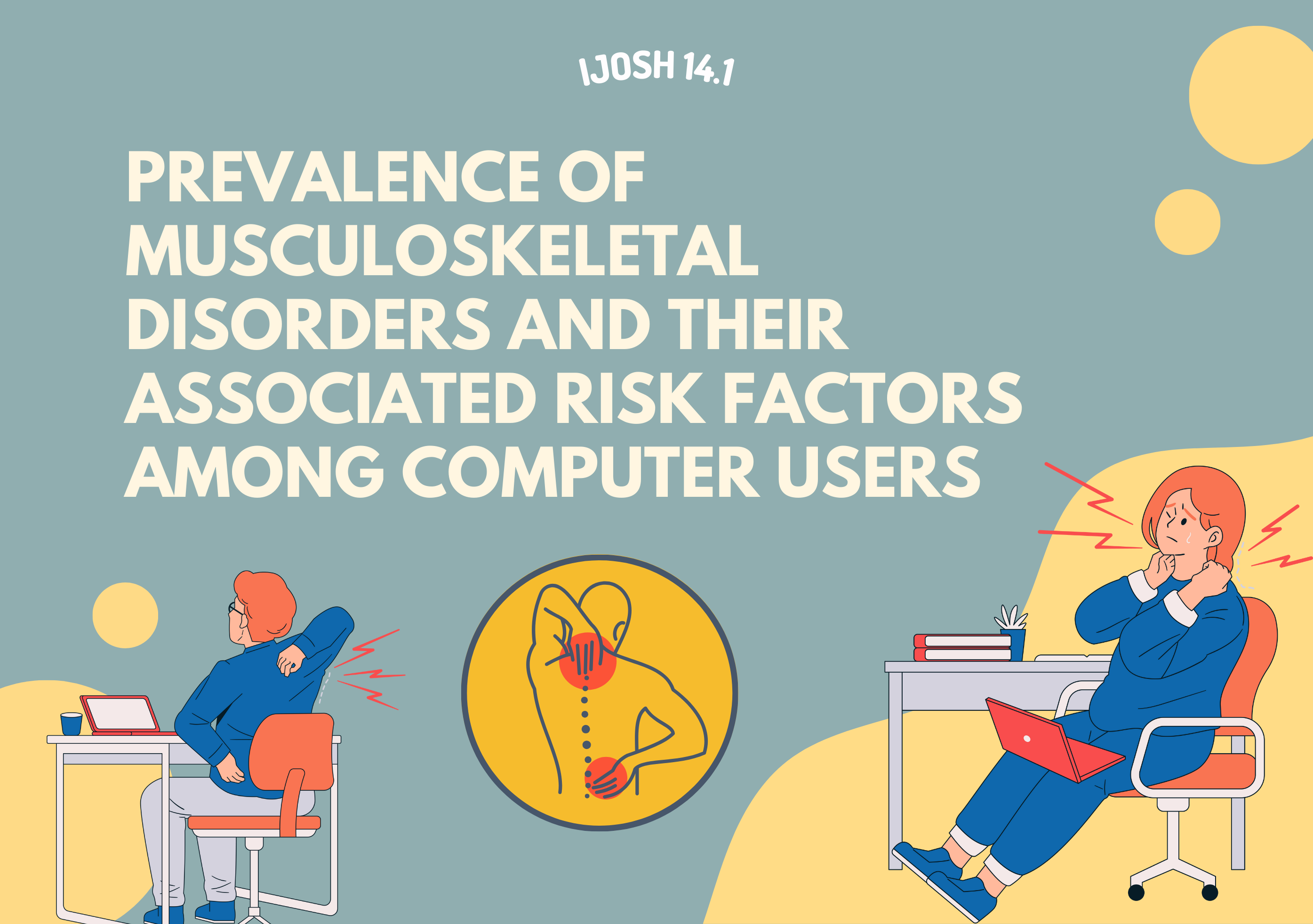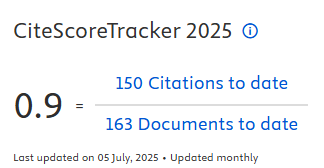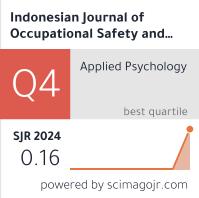Prevalence of Musculoskeletal Disorders and their Associated Risk Factors among Computer Users

Downloads
Introduction: In 21st century, computers are crucial devices in universities’ official operations. In academic institutions, musculoskeletal disorders (MSDs) are leading causes of decreased productivity, absenteeism, disability, and illness. Office staff who use computers extensively are vulnerable to occupational MSDs. This study aims to determine risk factors of MSDs among computer users in a public university. Methods: This cross-sectional study involved 320 respondents among computer users working in all departments in Universiti Sains Malaysia Health Campus using random sampling. Tools used were a self-administered questionnaire containing questions on socio-demographical data, Cornell Musculoskeletal Discomfort Questionnaire (CMDQ) for assessing musculoskeletal disorder and observation and Rapid Office Strain Assessment (ROSA) to assess office equipment and quantify exposure to risk factors in office work environment. Results: Response rate was 92% and 86.2% of respondents reported work-related musculoskeletal disorders (WRMSDs). The most prevalent MSD was lower back, 62.8% of MSD cases, followed by right shoulder (53.4%), hip/buttock (46.4%), and left shoulder (45.3%).Older age was significantly associated with WRMSDs (OR=6.944, CI:1.238-39.017, p=0.0.028) and with neck MSDs (OR=3.908, CI:1.342-11.377, p=0.012), while female gender was significantly associated with neck MSDs (OR=2.042, CI:1.199-3.475, p=0.009) and with upper arm MSDs (OR=1.791, CI:1.091-2.941, p=0.021). Older age was significantly associated with upper arm MSDs (OR=3.303, CI:1.006-10.849, p=0.049), while those with healthy and overweight were significantly associated with upper arm MSDs (OR=0.092, CI:0.010-0.814, p=0.046), (OR=0.127, CI:0.014-1.123, p=0.032), respectively. Conclusion: The prevalence of reported WRMSDs and MSDs at neck and upper arm were associated with socio-demographic background and high duration of computer use; 12.2% of workstation presented musculoskeletal discomfort risk.
Abas, A.H. et al. (2023) ‘Prevalence and Risk Factors of Low Back Pain in Malaysia: A Scoping review’, The Malaysian Journal of Medical Sciences, 30(3), pp. 32-41.
Australian Institute of Health and Welfare (2024) ‘Chronic Musculoskeletal Conditions. Australian Institute of Health and Welfare: Web Report
Algarni, F.S., Kachanathu, S.J. and AlAbdulwahab, S.S. (2020) ‘A Cross‐Sectional Study on the Association of Patterns and Physical Risk Factors with Musculoskeletal Disorders among Academicians in Saudi Arabia’, BioMed Research International, 2020(1), p. 8930968.
Alghadir, A.H., Khalid, S. and Iqbal, Z.A. (2022) ‘Work-related Musculoskeletal Disorders among Information Technology Professionals in Riyadh, Saudi Arabia’, Medycyna Pracy. Workers’ Health and Safety, 73(5), pp. 397–406.
Alhakami, A.M. et al.. (2022) ‘The Prevalence and Associated Factors of Neck Pain among Ministry of Health Office Workers in Saudi Arabia: A Cross Sectional Study’, Healthcare, 10(7), pp. 1-9.
Alias, A.N. et al. (2020) ‘Prevalence of Musculoskeletal Disorders (MSDS) among Primary School Female Teachers in Terengganu, Malaysia’, International Journal of Industrial Ergonomics, 77, p. 102957.
AlOmar, R.S. et al.. (2021) ‘Musculoskeletal Symptoms and their Associated Risk Factors among Saudi office Workers: A Cross-sectional Study’, BMC Musculoskeletal Disorders, 22, pp. 1–9.
Ardahan, M. and Simsek, H. (2016) ‘Analyzing Musculoskeletal System Discomforts and Risk Factors in Computer-using Office Workers’, Pakistan Journal of Medical Sciences, 32(6), p. 1425.
Arora, S.N. and Khatri, S. (2022) ‘Prevalence of Work-related Musculoskeletal Disorder in Sitting Professionals’, International Journal of Community Medicine and Public Health, 9, p. 892.
Askarianzadeh Mahabadi, M. et al. (2017) ‘Evaluation of Ergonomic Strains of the Telecommunication Bureau Staffs Using the Rapid Office Strain Assessment (ROSA)’, Journal of Occupational and Environmental Health, 3(3), pp. 197–204.
Borhany, T. et al. (2018) ‘Musculoskeletal Problems in Frequent Computer and Internet Users’, Journal of Family Medicine and Primary Care, 7(2), pp. 337–339.
Calik, B.B. et al.. (2014) ‘Upper Extremities and Spinal Musculoskeletal Disorders and Risk Factors in Students using Computers’, Pakistan Journal of Medical Sciences, 30(6), p. 1361.
Chinedu, O.O. et al. (2020) ‘Work-related Musculoskeletal Disorders among Office Workers in Higher Education Institutions: A Cross-sectional Study’, Ethiopian Journal of Health Sciences, 30(5).
Davudian-Talab, A. et al. (2017) ‘Evaluation and Correlation of the Rapid Upper Limb Assessment and Rapid Office Strain Assessment Methods for Predicting the Risk of Musculoskeletal Disorders’, Internal Medicine and Medical Investigation Journal, 2(4), pp. 155–160.
Demissie, B. et al. (2022) ‘Magnitude of work-related Musculoskeletal Disorders and its Associated factors among computer user bankers in South Gondar Zone, Northwest Ethiopia, 2021’, Environmental Health Insights, 16, pp. 11786302221125048–11786302221125048.
Demissie, B., Bayih, E.T. and Demmelash, A.A. (2024) ‘A Systematic Review of Work-related Musculoskeletal Disorders and Risk Factors among Computer Users’, Heliyon [Preprint].
Dieleman, J.L. et al.. (2020) ‘US Health Care Spending by Payer and Health Condition, 1996-2016’, Jama, 323(9), pp. 863–884.
Dimitrijević, V. et al.. (2023) ‘Prevalence of Computer Vision Syndrome in Computer Users: A Systematic Review and Meta-Analysis’, Vojnosanitetski Pregled, 80(10), pp. 860–870.
Ehsani, F. et al.. (2018) ‘Neck pain in Iranian school Teachers: Prevalence and Risk Factors’, Journal of Bodywork and Movement Therapies, 22(1), pp. 64–68.
Ehsani, F., Mosallanezhad, Z. and Vahedi, G. (2017) ‘The Prevalence, Risk Factors and Consequences of Neck Pain in Office Employees’, Middle East Journal of Rehabilitation and Health, 4(2).
Fatudimu, M.B., Odekunle, A. and Hamzat, T.K. (2022) ‘Point Prevalence and Risk Factors for Work-related Musculoskeletal Disorders among Academic Staff in a Nigerian University’, Journal of the Nigeria Society of Physiotherapy, 21(1), pp. 1–10.
Ghanbary, A. and Habibi, E. (2015) ‘Evaluation of Musculoskeletal Disorders among Computer Users in Isfahan’, Iranian Journal of Health, Safety and Environment, 2(3), pp. 330–334.
Ghanbary-Sartang, A. and Habibi, H. (2015) ‘Evaluation of Musculoskeletal Disorders to Method Rapid Office Strain Assessment (ROSA) in computers users’, Journal of Preventive Medicine, 2(1), pp. 47–54.
Gosain, L. et al. (2022) ‘Prevalence of Musculoskeletal Pain among Computer users Working from Home during the COVID-19 Pandemic: A Cross-Sectional Survey’, Bulletin of Faculty of Physical Therapy, 27(1), p. 51.
Hakam, M. and Nabilah, N. (2021) ‘Impact of Work Posture on Musculoskeletal Disorder in Nurses’, in The 3rd Joint International Conference, pp. 278–282.
Hasan, N.H., Zulkifly, S.S. and Ali, N.M. (2020) ‘The Risks of Work-related Musculoskeletal disorders among business service center workers’, Journal of Occupational Safety and Health, 17(2), p. 21.
Hedge, A., Morimoto, S. and McCrobie, D. (1999) ‘Effects of Keyboard Tray Geometry on Upper Body Posture and Comfort’, Ergonomics, 42(10), pp. 1333–1349.
Javed, W. et al. (2020) ‘Prevalence of Low Back Pain in Computer Users of Lahore, Pakistan’, Asian Journal of Allied Health Sciences (AJAHS), 4(3), pp. 38–41.
Joseph, L. et al. (2020) ‘Prevalence of Musculoskeletal Pain among Professional Drivers: A Systematic Review’, Journal of Occupational Health, 62(1), p. e12150
Kashif, M. et al. (2020) ‘Prevalence of Musculoskeletal Complaints of Arm, Neck and Shoulder and Associated Risk Factors in Computer Office Workers’, Physikalische Medizin, Rehabilitationsmedizin, Kurortmedizin, 30(05), pp. 299–305.
Kazeminasab, S. et al. (2022) ‘Neck Pain: Global Epidemiology, Trends and Risk Factors’, BMC Musculoskeletal Disorders, 23, pp. 1–13.
Khan, S.H. et al. (2020) ‘Posture Related Musculoskeletal Disorders (MSDs) among Computer Users in Higher Education Sectors of Malaysia.’, Malaysian Journal of Medicine & Health Sciences, 16.
Kibria, M.G. et al. (2023) ‘Evaluating the Ergonomic Deficiencies in Computer Workstations and Investigating Their Correlation with Reported Musculoskeletal Disorders and Visual Symptoms among Computer Users in Bangladeshi University’, Heliyon, 9(11).
Luxembourg (2023) State and Trends Publications Office of the European Union, Occupational safety and health in Europe. UNED - Universidad Nacional de Educacion a Distancia. http://dx.doi.org/ 10.2802/26873.
Malińska, M., Bugajska, J. and Bartuzi, P. (2021) ‘Occupational and Non-Occupational Risk Factors for Neck and Lower Back Pain among Computer Workers: A Cross-Sectional Study’, International Journal of Occupational Safety and Ergonomics, 27(4), pp. 1108–1115.
Medin-Ceylan, C. et al. (2023) ‘Risk Factors of Neck Disability in computer-using office workers: a cross-sectional study’, International Journal of Occupational Safety and Ergonomics, 29(1), pp. 44–49.
Mishalini Nair, A. et al. (2019) ‘Study on Prevalence and Risk Factors of Neck Pain among Aimst University Malaysia Academic Staffs’, International Journal of Innovative Technology and Exploring Engineering, 8(5).
Mohammadipour, F. et al. (2018) ‘Work-related Musculoskeletal Disorders in Iranian Office Workers: Prevalence and Risk Factors’, Journal of Medicine and Life, 11(4), p. 328.
Nunes, A. et al. (2021) ‘Neck Pain Prevalence and Associated Occupational Factors in Portuguese Office Workers’, International Journal of Industrial Ergonomics, 85, p. 103172.
OHS. (2022) ‘The Impact of Musculoskeletal Disorders on the Workforce’. Available at: https://ohsonline.com/articles/2022/05/18/the-impact-of-musculoskeletal-disorders.aspx (Accessed: 1 October 2024)
OSHA (2023) ‘eTools : Computer Workstations - Workstation Components’. Available at: https://www.osha.gov/etools/computer-workstations/components (Accessed: 1 October 2024)
Pattath, P. and Webb, L. (2022) ‘Computer-usage and Associated Musculoskeletal Discomfort in College Students’, Work, 73(1), pp. 327–334.
Redivo, V.S. and Olivier, B. (2021) ‘Time to Re-think Our Strategy with Musculoskeletal Disorders and Workstation Ergonomics’, South African Journal of Physiotherapy, 77(1), p. 1490.
Safiri, S. et al. (2020) ‘Global, Regional, and National Burden of Neck Pain in the General Population, 1990-2017: Systematic Analysis of the Global Burden of Disease Study 2017’, BMJ, 368.
Shariat, A. et al.. (2018) ‘Prevalence Rate of Neck, Shoulder and Lower Back Pain in Association with Age, Body Mass Index and Gender among Malaysian office Workers’, Work, 60(2), pp. 191–199.
Sonne, M., Villalta, D.L. and Andrews, D.M. (2012) ‘Development and Evaluation of an Office Ergonomic Risk Checklist: ROSA–Rapid office Strain Assessment’, Applied Ergonomics, 43(1), pp. 98–108.
Soo, S.Y. et al. (2023) ‘Occupational Ergonomics and Related Musculoskeletal Disorders among Dentists: A Systematic Review’, Work, 74(2), pp. 469–476
Thamrin, Y. et al. (2021) ‘Relation of Body Mass Index and Work Posture to Musculoskeletal Disorders among Fishermen’, Gaceta Sanitaria, 35, pp. S79–S82.
Yamin, M. (2019) ‘Information Technologies of 21st Century and their Impact on the Society’, International Journal of Information Technology, 11(4), pp. 759–766.
Ye, S. et al. (2017) ‘Risk Factors of Non-specific Neck Pain and Low Back Pain in Computer-using Office Workers in China: A Cross-Sectional study’, BMJ Open, 7(4), p. e014914.

This work is licensed under a Creative Commons Attribution-NonCommercial-ShareAlike 4.0 International License.

In order to be accepted and published by The Indonesian Journal of Occupational Safety and Health, Author(s) who submit an article should complete all the review process. The copyright of received articles assigned to the The Indonesian Journal of Occupational Safety and Health and Department of Safety and Health, Universitas Airlangga as publishers of the journal. The intended copyright includes the rights to publish articles in various forms (including reprints).
The Editorial Team of The Indonesian Journal Of Occupational Safety and Health and Department of Safety and Health strive to ensure that no errors occur in the articles that have been published, both data errors and statements in the article.
Users of this website will be licensed to use materials from this website following the Creative Commons Attribution-NonCommercial-ShareAlike 4.0 International License. No fees charged. Please use the materials accordingly.
------------------------------------------------------------------------------------------------------------------------------------------------------------------------------------------
Attribution ” You must give appropriate credit, provide a link to the license, and indicate if changes were made. You may do so in any reasonable manner, but not in any way that suggests the licensor endorses you or your use.
NonCommercial ” You may not use the material for commercial purposes.
ShareAlike ” If you remix, transform, or build upon the material, you must distribute your contributions under the same license as the original.







 How to Submit Articles in OJS
How to Submit Articles in OJS

























